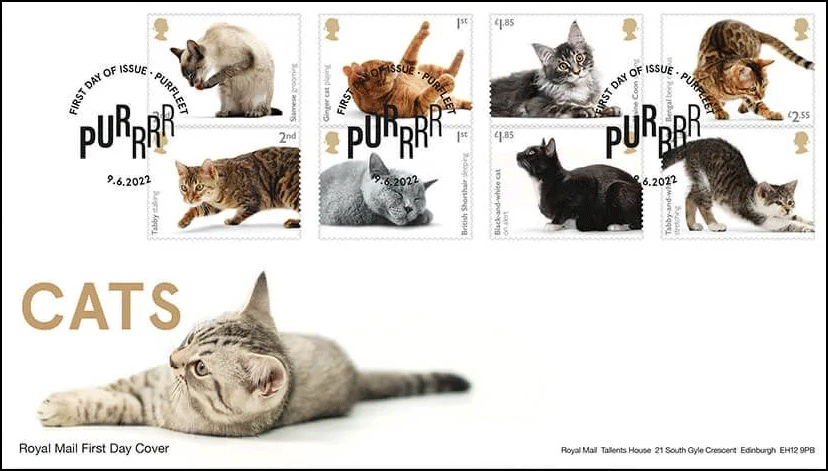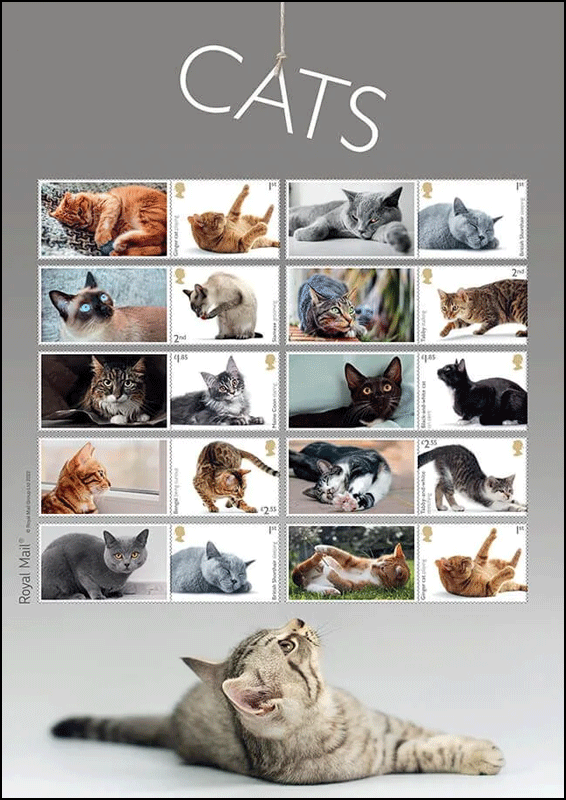[press release] [click on any of the pictures for larger versions]
Royal Mail Issues the Purr-Fect Set of Special Stamps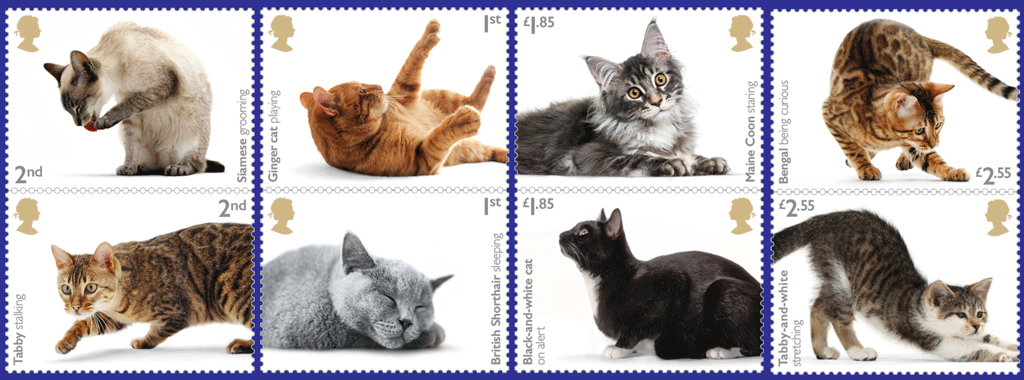
- The eight-stamp set show cats doing what they do best: grooming; stalking; playing; sleeping; staring; being on alert; being curious; and stretching
- Cats shown on the stamps are: Siamese; Tabby; Ginger cat; British Shorthair; Maine Coon; Black-and-white cat; Bengal; and a Tabby-and-white
- Both pedigree breeds and moggies represent the most popular owned cats in the UK
- There are over 10.2 million cats in the UK. Almost one in four UK households owns a cat* – or a cat owns them
- It is thought that cats were first domesticated around 10,000 years ago in the Middle East
- Royal Mail worked with author and animal expert, Tamsin Pickeral, author of The Grace of the Cat: An illustrated History, on the stamp issue
- The stamps are available at www.royalmail.com/cats, by phone on 03457 641 641 and at 7,000 Post Offices. A Presentation Pack, containing all eight stamps, is priced at £12.96
Royal Mail has launched the purr-fect new set of eight stamps featuring beautiful images of 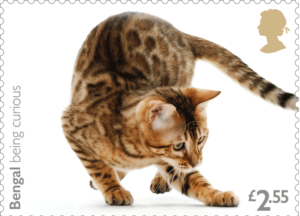 cats doing what they do best.
cats doing what they do best.
The images show cats: grooming; stalking; playing; sleeping; staring; being on alert; being curious; and stretching.
Cats shown on the stamps are: Siamese; Tabby; Ginger cat; British Shorthair; Maine Coon; Black-and-white cat; Bengal; and a Tabby-and-white.
The cats include a mix of pedigree breeds and moggies representing some of the most popular owned cats in the UK – each is then shown on the stamps in characteristic 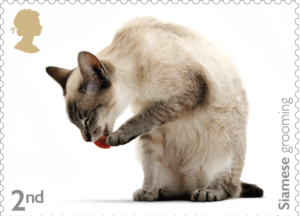 behaviour.
behaviour.
Royal Mail worked with author and animal expert, Tamsin Pickeral, author of The Grace of the Cat: An illustrated History on the stamp issue.
Domestic cats have a broad range of language to let their owners know what they do – or don’t want! After birds, they have the widest range of vocalisation of any domestic pet. Some breeds are far chattier than others, for example, the Siamese and Burmese are particularly vocal.
Some amazing cat facts include:
- Domestic cats share 96% of their genes with tigers
- Sir Isaac Newton is credited with inventing the cat flap
- There are over 10.2 million cats in the UK
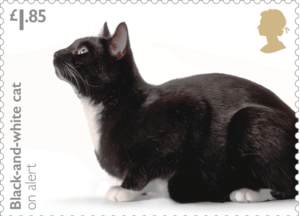 Almost one in four UK households owns a cat* – or a cat owns them
Almost one in four UK households owns a cat* – or a cat owns them- The Post Office formally employed cats between 1868 and 1984 to keep out mice
- Cats have only a few hundred taste buds compared to a human’s 9,000
- Cats have up to 200 million odour-sensitive cells in their noses, compared to humans who have just 5 million
- Cats also have a ‘second nose’, the vomeronasal scent organ, located on the roof of their mouth, which is able to detect pheromones
A brief history of the cat:
It is thought that cats were first domesticated around 10,000 years ago in the Middle East. 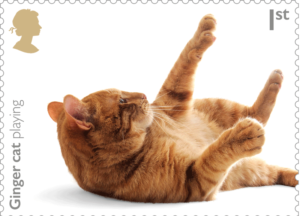 This coincided with the establishment of settlements and farming, and the subsequent rise of the rodent. Genetic analysis confirms the domestic cat is a descendent of the African wildcat (Felis silvestris lybica), a native of that area.
This coincided with the establishment of settlements and farming, and the subsequent rise of the rodent. Genetic analysis confirms the domestic cat is a descendent of the African wildcat (Felis silvestris lybica), a native of that area.
The earliest evidence of the human–cat relationship is a grave in Cyprus of an adult human and a kitten carefully placed together, thought to date from around 9,500 years ago. Fast forward to ancient Egypt, some 4,000 years ago, and cats appear frequently in artworks depicting domestic 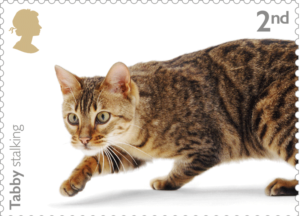 settings. They were associated with the Goddess Isis and her daughter Bastet. These depictions show a striking similarity to the modern Egyptian Mau.
settings. They were associated with the Goddess Isis and her daughter Bastet. These depictions show a striking similarity to the modern Egyptian Mau.
Cats spread through Greece and Rome, transported on grain ships to keep mice at bay, and with the expansion of the Roman Empire they were soon to be found across Europe and the British Isles. These short-haired cats are believed to be the ancestor of the British Shorthair. Just as cats were populating the West, they were also spreading eastwards as trade routes opened with the Far East.
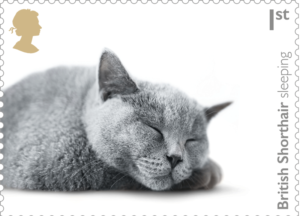 Cats were highly valued for their rodent control, but it was their enigmatic nature that led to their reverence as magical beings and association with myths and legends – particularly in China, Japan, India and Persia (modern-day Iran). It was here that the Persian breed evolved with its thick coat to keep out the biting cold.
Cats were highly valued for their rodent control, but it was their enigmatic nature that led to their reverence as magical beings and association with myths and legends – particularly in China, Japan, India and Persia (modern-day Iran). It was here that the Persian breed evolved with its thick coat to keep out the biting cold.
The Middle Ages in Europe was a dark period for the cat. As Christianity rose, their links to pagan religions and misplaced associations with magic and witchcraft saw them being systematically culled. 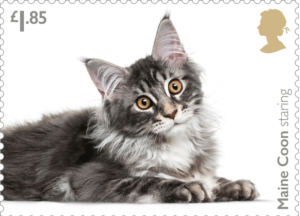 Unsurprisingly, there was simultaneously a huge increase in rat-borne plagues, culminating in the Black Death, which is thought to have killed up to 60 per cent of Europe’s population.
Unsurprisingly, there was simultaneously a huge increase in rat-borne plagues, culminating in the Black Death, which is thought to have killed up to 60 per cent of Europe’s population.
Cats were on board the first ships sailing to the New World from England in the 1620s; these hardy creatures were most likely the ancestors of today’s Maine Coon and American Shorthair. By the 18th century, the fortunes of cats changed forever, and they were favoured by literati like Byron, Keats and Sir Walter Scott.
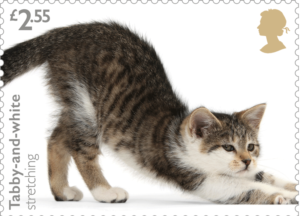 By the time of the inaugural cat show in London’s Crystal Palace in 1871, there were Russian Blues, Abyssinians, Persians, Siamese and Angoras in the country alongside British Shorthair and Manx. The show proved a great success and was a key moment in modern cat history, followed closely by the establishment of a number of cat clubs and finally, in 1910, by the Governing Council of the Cat Fancy (GCCF), which took over as the sole registry for pure-bred cats in Britain.
By the time of the inaugural cat show in London’s Crystal Palace in 1871, there were Russian Blues, Abyssinians, Persians, Siamese and Angoras in the country alongside British Shorthair and Manx. The show proved a great success and was a key moment in modern cat history, followed closely by the establishment of a number of cat clubs and finally, in 1910, by the Governing Council of the Cat Fancy (GCCF), which took over as the sole registry for pure-bred cats in Britain.
David Gold, Director External Affairs & Policy, Royal Mail, said: “These beautiful stamps showing cats being cats, show why as a nation, we are besotted with them. Their enchanting, independent and quirky ways are perfectly captured in these images that all animal lovers will adore.”
The stamps are available now at www.royalmail.com/cats and by phone on 03457 641 641, with a Presentation Pack, containing all eight stamps, priced at £12.96.
*Source: PDSA UK pet populations of dogs, cats and rabbits 2021
Shown below: The official first day cover and the “collectors sheet.”